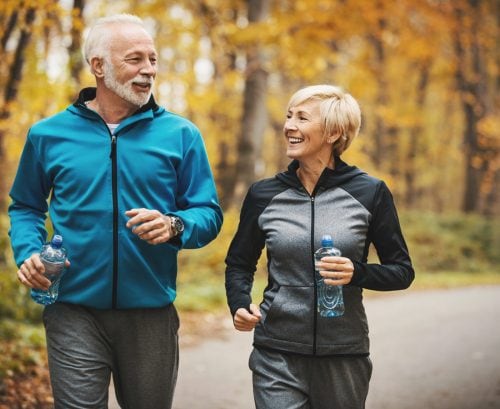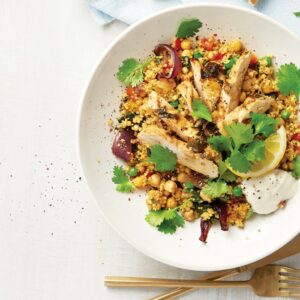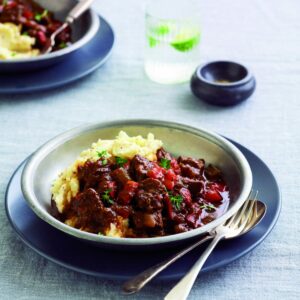
Staying strong is essential to good health as we age. Senior nutritionist Rose Carr explains.
Even if we don’t want to look like famous bodybuilder Charles Atlas or a female counterpart, building and maintaining muscle can have a big impact on our quality of life as we get older.
What is sarcopenia?
Sarcopenia is a progressive and generalised loss of skeletal muscle mass and strength and is commonly experienced as we age. Sarcopenia is strongly linked with physical disability, reduced quality of life and earlier death.
We use our skeletal muscles to move and to stabilise our bodies.
For much of our lives we probably take this for granted even if we don’t do a lot of exercise. We understand some people are stronger and may be able to do things we can’t do, like walk a tightrope or jog up the stairs. Generally, we don’t think too much about how our muscles help us get up from that chair or stabilise us while walking over those rocks – until we learn the hard way. Older people know just how important skeletal muscles are and how much we rely on them.
Studies have also shown a link between muscle health and bone health. This may be due to specific hormones, as well as exercise levels, that affect the health of both muscle and bone.
It may even be due to ‘bone-muscle cross-talk’ or biochemical communication between the two, rather than just the mechanical interactions we’re more familiar with. However it works, we do know that as we lose muscle mass and function, we’re more prone to falls, and when we have that fall, we’re also more likely to suffer a fracture and possibly lose our independence.
Aiming to maintain a healthy weight as we age is also important. Research has shown obesity in older age is associated with a greater rate of loss of muscle mass and muscle quality, increasing the likelihood of disability and reduced mobility. Risk factors for sarcopenia also include physical activity and diet.
We can’t do anything about our genetic makeup and, clearly, we can’t stop getting older and experiencing the inevitable hormonal changes associated with that, so let’s look at how we can make a difference.
Exercise is key
Muscle tissues change as we age. It’s inevitable we will lose some strength but how rapid and significant those changes are can be partly mitigated by physical activity.
One study compared long-term regular exercisers, with an average age of 70, with healthy sedentary counterparts as well as younger men, average age 27.
Despite noting some wasting of muscle fibres, the researchers found the skeletal muscle of the older sportsmen was more similar to the young men than to the age-matched sedentary men. That’s good news for the regular exercisers but we also have good news for everyone else.
Both research on people who’ve spent time in gravity-free spacecraft and those who’ve been bed-bound shows that inactivity is the enemy of our muscles, but further research shows it’s never too late to start building muscle. In a study of frail nursing home residents (average age 87 years) muscle strength increased by 113 per cent with progressive resistance exercise over 10 weeks and their mobility improved too.
Build muscle at any age
There are four types of exercise or training recommended as we age:
Resistance
This exercise is anything that requires our muscles to move or resist weight. This includes lifting weights, using a resistance band, using our body weight for resistance (think push-up or pull-up), climbing stairs, carrying a heavy load or even heavy gardening.
Flexibility
Flexibility means being able to move our joints through their full range of motion.
Losing flexibility in our hip, knee and ankle joints affects our gait and our risk of falls as we get older.
Exercises to enhance this include stretching, tai chi and yoga.
Aerobic
Anything that gets us puffing a little, such as brisk walking, swimming, dancing or cycling would be considered aerobic.
Although we have been focusing on muscle, aerobic exercise not only helps heart health and in reducing chronic inflammation, it also helps preserve muscle. And there’s no doubt it helps with daily activities as we get older.
Balance
Balance helps maintain stability in daily activities and prevents falls. Like flexibility, we probably take balance for granted but if we don’t train ourselves to maintain balance, we can lose it as we age.
You’ll need to have maintained muscle strength to do this, so it is all interlinked. Practise your balance when standing on a moving bus or train, or by standing on one leg, walking backwards, or taking up tai chi.
Getting started
When starting exercise, we need to begin at an appropriate level, so we don’t hurt ourselves. If we progressively do more we can improve, maintain or at least slow the decline of our muscle strength, flexibility, aerobic capacity and balance.
Finding your starting point will depend on your fitness level. See your GP if you have any doubts about what you ought to be doing but be sure of one thing, you’re never too old or too unfit to do something.
Here are some ways to get started on your exercise regime:
Go to a gym
I resisted this for years because I found them daunting until I finally realised that they come in different forms (just like us). If you shop around you might find one where you feel comfortable.
Get a personal trainer
This sounds expensive but it doesn’t have to be more than once a week and it doesn’t have to be forever. It’s a great way to get going when you’re not sure about what you can do or how to do it. Having a regular appointment is also a good motivator.
Find a class (or two)
There are loads of classes out there, from yoga to kickboxing. Gyms offer lots of different options, but you’ll find classes at community groups too with some focussed on the over 60s.
Google ‘exercise classes’ or ‘exercise classes for seniors’ to find what’s available in your area. For example, in Auckland, AUT run daily ‘never2old’ sessions in their weights room. Don’t forget to see what’s on offer at local dance studios and swimming pools.
Find a buddy
Exercising can be a daunting prospect if it has not been part of your life. See if you can persuade a partner, work buddy or friend to join you on the journey.
Check out YouTube
Give the lycra-clad young things a miss by searching ‘exercise for older non-exerciser’ and you’ll find some low-impact and seated exercise videos along with loads of other options.
The importance of protein
We build and maintain muscle by using our muscles but protein from our diet is also essential. As we age our bodies become resistant to building muscle and we need more protein to stimulate muscle growth.
At a time when our overall energy needs are a little lower, we still need to up our protein intake and displace some of those low-nutrition foods, such as cakes and confectionery.
A US study of over 2000 men and women aged 70-79 years old compared their diets and muscle mass over a three-year period.
The 20 per cent having the highest protein diets lost around 40 per cent less muscle mass than the 20 per cent with the lowest protein diets. And a 2019 US study of nearly 12,000 people aged over 50 years found those not meeting protein recommendations had significantly more functional limitations.
As we age, we may also be more prone to illness which can hinder muscle building. When we’re unwell or recovering from sickness, getting plenty of protein is essential for a speedy recovery.
The inflammation link
Evidence is also growing that higher levels of inflammation are associated with physical decline as we age, possibly through the effects of inflammatory markers, such as tumour necrosis factor-alpha (TNF-a), on muscle. It makes sense that an anti-inflammatory diet could also help us maintain muscle along with reducing our risk for chronic diseases including Alzheimer’s and type 2 diabetes.
While it’s true that protein can be a bit inflammatory, saturated fat is far more so and, therefore, it’s all about balance. A Mediterranean-style diet, which includes fish and a little red meat as well as loads of colourful veges and fruit, whole grains, legumes and nuts, is a great place to start.
Up the protein
People aged 70 years and older need more protein.
The recommendation is 1.07g protein per kg body weight per day for men, and for women it’s 0.94g per kg. For a 70kg man that’s 75g protein a day, and for a 60kg woman 56g protein each day. Aim to include protein at every meal and in snacks.
- 120g portion of beef, pork, lamb or chicken: 23g-26g
- 120g fillet of fish: 18g-24g
- 100g portion of tofu or tempeh: 12g-19g
- small can of tuna or salmon: 12g-22g
- ½ can lite baked beans with 1 slice grainy bread: 13g
- 40g cheddar cheese: 9g-12g
- ½ cup thick Greek-style/ high-protein yoghurt: 11g
- 1 egg with 1 slice grainy bread: 11g
- 1 medium baked potato with 3 tablespoons cottage cheese: 11g
- ¼ cup rolled oats with ½ cup calcium-fortified trim milk: 10g
- ½ cup edamame: 10g
- ¼ cup peanuts: 9g
- ¼ cup almonds: 8g
- ¼ cup cashew nuts: 7g
Article sources and references
- Beaudart C et al. 2017. Nutrition and physical activity in the prevention and treatment of sarcopenia: Systematic review. Osteoporosis International 6:1817-33https://www.ncbi.nlm.nih.gov/pubmed/28251287
- Edwards MH et al. 2016. Osteoporosis and sarcopenia in older age. Bone 80:126-30https://www.ncbi.nlm.nih.gov/pmc/articles/PMC4601530/
- Fiatarone MA et al. 1994. Exercise training and nutritional supplementation for physical frailty in very elderly people. New England Journal of Medicine 330:1769-75https://www.ncbi.nlm.nih.gov/pubmed/8190152
- Goodpaster BH et al. 2016. The loss of skeletal muscle strength, mass, and quality in older adults: The Health, Aging and Body Composition Study. Journals of Gerontology 61A:1059–64
- Granic A et al. 2019. Dietary patterns, skeletal muscle health, and sarcopenia in older adults. Nutrients 11:745https://www.ncbi.nlm.nih.gov/pubmed/30935012
- Houston DK et al. 2008. Dietary protein intake is associated with lean mass change in older, community-dwelling ads: The Health, Aging, and Body Composition (Health ABC) Study. American Journal of Clinical Nutrition 87:150-5https://academic.oup.com/ajcn/article/87/1/150/4633334
- Kortebein P et al. 2008. Functional impact of 10 days of bed rest on skeletal muscle in healthy older adults. Journals of Gerontology 63A:1076-81https://academic.oup.com/biomedgerontology/article/63/10/1076/559225
- Koster A et al. 2011. Does the amount of fat mass predict age-related loss of lean mass, muscle strength, and muscle quality in older adults? Journals of Gerontology 66A:888-95https://www.ncbi.nlm.nih.gov/pubmed/21572082
- Krok-Schoen JL et al. 2019. Low dietary protein intakes and associated dietary patterns and functional limitations in an aging population: A NHANES analysis. Journal of Nutrition, Health & Aging 23:338-47https://www.ncbi.nlm.nih.gov/pubmed/30932132
- McGregor RA et al. 2014. It is not just muscle mass: a review of muscle quality, composition and metabolism during ageing as determinants of muscle function and mobility in later life. Longevity & Healthspan 3:9https://www.ncbi.nlm.nih.gov/pubmed/25520782
- Montero-Fernandez N & Serra-Rexach JA. 2013. Role of exercise on sarcopenia in the elderly. European Journal of Physical and Rehabilitation Medicine 49:131-43https://www.ncbi.nlm.nih.gov/pubmed/23575207
- Morley JE et al. 2010. Nutritional recommendations for the management of sarcopenia. Journal of the American Medical Directors Association 11:391-6https://www.ncbi.nlm.nih.gov/pubmed/20627179
- Muscaritoli M et al. 2010. Consensus definition of sarcopenia, cachexia and pre-cachexia: Joint document elaborated by Special Interest Groups (SIG) ‘‘cachexia-anorexia in chronic wasting diseases’’ and ‘‘nutrition in geriatrics’’. Clinical Nutrition 29:154-9https://www.ncbi.nlm.nih.gov/pubmed/20060626
- Ni Lochlainn M et al. 2018. Dietary protein and muscle in aging people: The potential role of the gut microbiome. Nutrients 10:929https://www.ncbi.nlm.nih.gov/pubmed/30036990
- Peterson MD et al. 2011. Resistance exercise for the aging adult: Clinical implications and prescription guidelines. American Journal of Medicine 124:194-8https://www.ncbi.nlm.nih.gov/pubmed/21396499
- Reginster J-Y et al. 2015. Osteoporosis and sarcopenia: two diseases or one? Current Opinion in Clinical Nutrition and Metabolic Care 19:31-6https://www.ncbi.nlm.nih.gov/pubmed/26418824
- Santilli V et al. 2014. Clinical definition of sarcopenia. Clinical Cases in Mineral and Bone Metabolism 11:177-80https://www.ncbi.nlm.nih.gov/pubmed/25568649
- Schaap LA et al. 2009. Higher inflammatory marker levels in older persons: associations with 5-year change in muscle mass and muscle strength. Journals of Gerontology 64A:1183–9https://www.ncbi.nlm.nih.gov/pubmed/19622801
- Zampieri S et al. 2014. Lifelong physical exercise delays age-associated skeletal muscle decline. Journals of Gerontology 70A:163-73https://www.ncbi.nlm.nih.gov/pubmed/24550352
www.healthyfood.com










